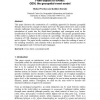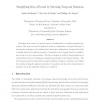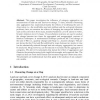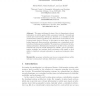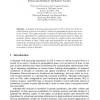GISCIENCE
2004
Springer
14 years 7 months ago
2004
Springer
This paper discusses the construction of a modeling approach for dynamic geospatial domains based on the concepts of object and event. The paper shows how such a model extends tra...
GISCIENCE
2004
Springer
14 years 7 months ago
2004
Springer
We investigate the understanding of landmarks using a model of embedding procedures that sees affordances established on three levels. On the first level there are landmark experie...
GISCIENCE
2004
Springer
14 years 7 months ago
2004
Springer
Reasoning about events or temporal aspects is fundamental for modeling geographic phenomena. This work concerns the analysis of events as configurations of temporal intervals. It...
GISCIENCE
2004
Springer
14 years 7 months ago
2004
Springer
This paper investigates the influence of category aggregation on measurement of land-use and land-cover change. To date, research concerning data aggregation has examined primarily...
GISCIENCE
2004
Springer
14 years 7 months ago
2004
Springer
Abstract. Across the globe individuals and organizations are creating geographic data work products with little ability to efficiently or effectively make known and share those dig...
GISCIENCE
2004
Springer
14 years 7 months ago
2004
Springer
This paper addresses the issue of how to disseminate relevant information to mobile agents within a geosensor network. Conventional mobile and location-aware systems are founded on...
GISCIENCE
2004
Springer
14 years 7 months ago
2004
Springer
The spatial auto-regression (SAR) model is a popular spatial data analysis technique, which has been used in many applications with geo-spatial datasets. However, exact solutions f...
GISCIENCE
2004
Springer
14 years 7 months ago
2004
Springer
Abstract. The SPIRIT search engine provides a test bed for the development of web search technology that is specialised for access to geographical information. Major components inc...
GISCIENCE
2004
Springer
14 years 7 months ago
2004
Springer
Abstract. A datatype with increasing importance in GIS is what we call the location history–a record of an entity’s location in geographical space over an interval of time. Thi...
GISCIENCE
2004
Springer
14 years 7 months ago
2004
Springer
Abstract. Integration of GIS and hydrologic models has been a common approach for monitoring our ever-changing hydrologic system. One important issue in adapting such an approach i...
